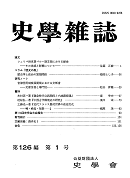All issues

Volume 127, Issue 3
Displaying 1-4 of 4 articles from this issue
- |<
- <
- 1
- >
- >|
-
2018 Volume 127 Issue 3 Pages Cover1-
Published: 2018
Released on J-STAGE: March 20, 2019
JOURNAL FREE ACCESSDownload PDF (295K) -
2018 Volume 127 Issue 3 Pages Cover2-
Published: 2018
Released on J-STAGE: March 20, 2019
JOURNAL FREE ACCESSDownload PDF (202K) -
Setbacks in the Japanese occupation of central China and its policy of cooperation with Britain and the U.S.Fumi YOSHII2018 Volume 127 Issue 3 Pages 1-36
Published: 2018
Released on J-STAGE: March 20, 2019
JOURNAL FREE ACCESSThis article discusses the diplomatic issues which arose after Japan attempted to monopolize navigation on the Yangtze River during the 2nd Sino-Japanese War, by focusing on the two inconsistencies in Japanese occupation policy of avoiding a declaration of war and seeking cooperation with Britain and the U.S. under the concept of a the New Order in Asia.
While Britain and the U.S. demanded the resumption of free navigation as soon as the fighting on the Yangtze stopped, Japan refused to reopen the River citing security issues, even after the fall of Hankow. Criticizing such an attitude, Britain and the U.S. pointed out that since only Japanese commercial ships were allowed to navigate the Yangtze freely, Japan was engaging in de facto occupation of the region. In response, Japan refused to reopen the waterway on the premise that they were indeed pursuing such a policy.
The author then turns to Japanese Foreign Minister Arita Hachiro who favored opening the Yangtze as a gesture of cooperation towards toward Britain and the U.S. and his advocacy of the New Order in Asia. Arita planned to open the Yangtze and rebuild friendly relations with Britain and the U.S. on the strength of domestic support for his tough attitude; however, due to stagnation in the implementation of the occupation policy, the expected date of the opening, suggested by the Koain 興亜院 planning agency, was postponed. The article also covers the local situation which presented more difficulties in opening the Yangtze, from the viewpoints of monetary currency, navigation and commercial conditions.
Faced with U.S. threats to abrogate the Japan-U.S. commerce and navigation treaty, Japan finally agreed to partly open the Yangtze, based on a strategy to influence the U.S. directly and indirectly in setting up a modus vivendi, but the U.S. and Britain did not respond as Japan hoped, while at the same time actual preparations to open the river bogged down, preventing Japan from keeping its verbal promise. This whole incident shows not only Japan’s failure in diplomatic cooperation and implementing its occupation policy, but also the difficulties faced by the Wang Chingwei 汪精衛 Government to develop its economic foundation.View full abstractDownload PDF (3996K) -
Miki UTSUNOMIYA2018 Volume 127 Issue 3 Pages 40-65
Published: 2018
Released on J-STAGE: March 20, 2019
JOURNAL FREE ACCESSThe research to date on granaries in dynastic China has developed as one means for identifying the workings of state systems from the perspective of these storage facilities forming the foundation of fiscal administration. The work done so far on the Sui and Tang Periods has tended to focus exclusively on the findings of the archeological survey conducted at the Tang period Hanjiacang 含嘉倉 site in Luoyang, thus overlooking the existence and importance of the three Sui period granaries serving the capital, Ziluocang 子羅倉, Luokoucang 洛口倉 and Huiluocang 回洛倉. Therefore, the present article is an attempt to use both archeological data and the texts of the civil codes (ling 令) of the two periods to shed light upon the characteristic features and historical development of these four granaries of Luoyang, including their specific locations, functions and interrelationships, with the intent of examining the transition from the three Sui granaries to the Tang Hanjiacang facility, thus reconsidering the significance of underground grain storage for the Chinese state during the two periods.
The author begins with a review of the sources related to the four granaries, looking specifically for storage capacity indicators from the field measurements of excavated subterranean stores (jiao 窖), as well as data on facility scale, structure and choice of location. Next, this data is correlated to the related ling civil codes in order to confirm how granaries were actually operated during the two periods, followed by a multi-faceted comparison between the three Sui facilities and the Hanjiacang, in order to grasp the process by which administrative practices were changing over the two periods.
From this investigation, the author identifies the Ziluocang facility as a granary for storing food and drink to meet the Imperial court’s daily needs, Luokoucang as a transit granary to destinations in Luoyang and Chang’an 長安, as well as a storehouse for supplying imperial troops stationed in the north, and Huiluocang as the main granary operating in the capital, concluding that all three formed a division of labor during the latter part of the Sui period in serving Luoyang. In contrast, the appearance of the Hanjiacang granary during the reign of Emperor Gaozong 高宗 in the early Tang period marked the integration of all the functions and tasks of the three Sui granaries into one facility, despite the fact of a reduction in its scale.
The reason why Hanjiacang was able to adequately respond to increasing storage demands over the years was an improvement in operational efficiency made possible by reforms in related ling code provisions. That is to say, the transition from three Sui granaries to one Tang facility constituted not merely a mechanical change in granary structure, location, etc., but also reflected improvements in administrative practices over time and the maturation of underground granary management technology during the Tang Period.View full abstractDownload PDF (3441K)
- |<
- <
- 1
- >
- >|